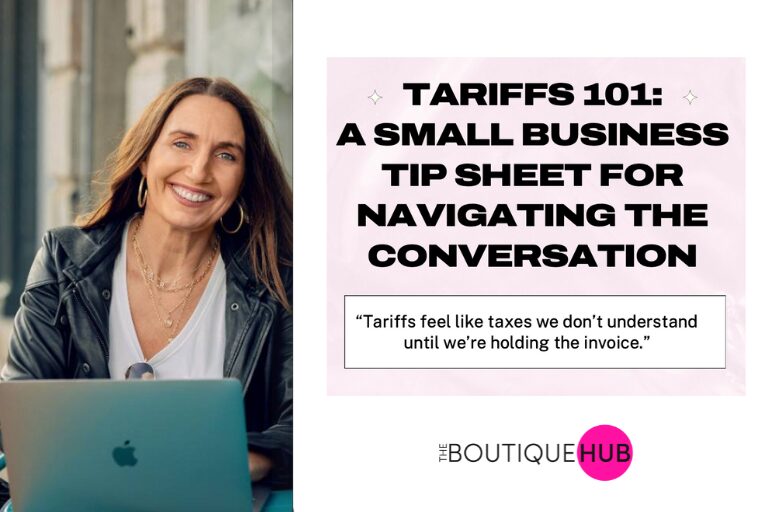
“Tariffs feel like taxes we don’t understand until we’re holding the invoice.” – The Boutique Hub
Tariffs are taxes placed on goods that are imported from other countries. They’re designed to protect domestic industries by making imported products more expensive.
Why it matters to YOU:
If you’re sourcing inventory (clothing, gifts, home goods, etc.) from overseas suppliers—especially in countries like China, Vietnam, or India—tariffs might increase the landed cost of those products. That means your wholesale cost goes up… and you either absorb it or pass it on to customers.
Think of Tariffs Like This:
You’ve been buying candles for $5 each from your vendor overseas. Now, suddenly, there’s a 25% tariff on imported candles from that country. So your candle now costs $6.25 instead of $5.
You either raise your price… Or make less profit… Or find another source.
That’s the fork in the road most businesses are standing at right now.
- Know What You’re Actually Buying
Start by understanding your product’s country of origin and tariff classification (called an HS code). Your wholesaler or freight forwarder should have this. Tip: Ask your supplier, “Can you confirm the country of origin and HS code for this item?”
- Build Relationships with Suppliers
The best vendors communicate changes upfront. Ask: “Are there any expected cost increases due to tariffs?” “Are there other countries you source from that avoid these tariffs?” “Can you hold your pricing for the next 90 days?”
- Understand Your Margins Before You Panic
If a tariff adds $0.40 to a $6 item and your markup is still healthy, it may not be worth stressing over. But if your margins are already tight, you’ll need to make moves. Tip: Always run a quick “cost increase” simulation. Ask: How much would a 5–10% increase in COGS impact my bottom line? Would I need to increase prices? Can I bundle or repackage to preserve the margin?
- Communicate Price Increases Thoughtfully
If you do need to raise prices, communicate the “why” to your customers. People appreciate honesty more than surprise. Do not come across as desperate or controversial. Example: “We’re committed to quality, and while tariffs are increasing our costs, we’re doing everything we can to keep prices fair. Thank you for supporting a business that supports people—not politics.”
- Watch the News, But Don’t Let It Run Your Store
Tariff changes often come in waves and headlines. What’s proposed doesn’t always go into effect. So don’t make knee-jerk decisions on a headline alone. Tip: Follow updates from U.S. Customs & Border Protection, your industry associations, or your freight forwarder.
- Plan Inventory & Timing Around Tariff Changes
If a new tariff is expected to take effect next quarter, ask your vendors about ordering now and warehousing or drop-shipping later to avoid the hike.
- Don’t Stop Buying!
Freshness is key to keeping customers returning. Vendors need your business to survive. Stay active, ask questions, and maintain relationships.
- Explore Nearshoring or Domestic Vendors
This could be the moment to audit your supply chain. Many small brands are now working with manufacturers in the U.S., South America, Canada, or Mexico.
- Lean Into Your Community at The Boutique Hub
We’re working with experts and bringing you more info as it develops.
- Should Retailers Expect Vendors to Remove Tariff Fees If Tariffs Are Removed?
– Transparent vendors might remove them.
– Vendors who baked it into price likely won’t.
– Most won’t reduce prices even if tariffs go away—pricing becomes the new normal.
Tariff Hangover Reality:
Even when tariffs go away, pricing changes are slow. Vendors cite existing inventory, labor/freight costs, or uncertainty.
Bottom Line:
Tariffs aren’t the end of the world. Stay curious and strategic. Know your numbers. Know your products. Know your options. Lean on your community.
EXAMPLES OF TARIFF IMPACTS:
- Clothing from China – $15 shacket + 25% tariff = $18.75. Retail price may need to increase.
- Home Decor from India – $10 lanterns + 10% tariff = $11. A 500-unit order = $500 added cost.
- Backpacks from Vietnam – $12 bag + 15% = $13.80. For 1,000 units = $1,800.
- Beauty from Korea – $4 face mask = $4.80. $10 serum = $12. Disrupts pricing tiers.
- Home Furnishings from China – $100 chair + $25 tariff + $50 freight = $175 landed cost. Profit margin shrinks.
This article was written by Sara Burks and reprinted with permission of The Boutique Hub.
Use these examples to explain tariff effects to team/customers clearly but calmly.
If you enjoyed this article, find more resources like this one here at The Boutique Hub.
